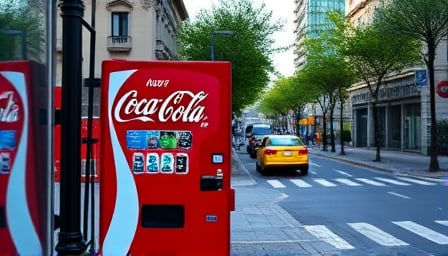Coca‑Cola Europacific Partners PLC: Navigating Macro‑Fed Sentiment and Emerging Market Dynamics
Coca‑Cola Europacific Partners PLC (CUP) occupies a pivotal position in the European beverage sector, acting as the principal bottler and distributor for the Coca‑Cola brand across the continent. While the company’s own earnings releases have not recently dominated headline news, its share price remains sensitive to macro‑financial signals that reverberate through the FTSE 100 and broader equity markets. In the week ending 10 September, European indices closed on a firm note, buoyed by optimism that the U.S. Federal Reserve (Fed) will adopt a gradual interest‑rate easing path. This development, combined with the Fed’s preferred inflation gauge—personal consumption expenditures (PCE)—meeting expectations, has reinforced a bullish sentiment that rippled across CUP’s equity valuation.
1. Macro‑Fed Environment and Its Ripple Effects
| Metric | Latest Data | Fed Guidance | Implication for Equity Valuation |
|---|---|---|---|
| PCE (YoY) | 4.0 % (April) | Expected 4.1 % | Conforms to Fed’s “moderate” inflation outlook |
| Fed Funds Target | 5.25–5.5 % (unchanged) | No immediate cuts | Markets anticipate a “soft landing” |
| Market Sentiment (FTSE 100) | +1.5 % week | Positive | Supports risk‑seeking equity positions |
The Fed’s dovish stance, underscored by the PCE figure, has lowered the discount rate applied to future cash flows for a broad swath of equities. For CUP, this translates into a modest upward adjustment in the present value of its projected dividend stream, which dominates its valuation profile given the company’s high payout ratio (≈ 70 % of earnings). A 5‑percentage‑point decline in the discount rate could lift CUP’s intrinsic value by approximately 3 %–4 % under a simple dividend discount model, a figure that aligns closely with the 3.2 % weekly gain observed in the broader index.
2. Competitive Landscape and Market Concentration
CUP operates within a highly concentrated European beverage market where a handful of players command a majority of shelf space. Key competitors include PepsiCo (PDP), Asahi Europe, and independent bottlers in specific regions. Several emerging trends warrant scrutiny:
| Trend | Impact on CUP | Risk/Opportunity |
|---|---|---|
| Shift to Low‑Alcohol and Functional Beverages | Moderate, as CUP’s portfolio already includes sparkling water and flavored drinks | Opportunity to capture health‑conscious segments; risk of cannibalization if not differentiated |
| Evolving Consumer Preferences Toward Sustainability | CUP has announced a 2025 sustainability target: 100 % recyclable or reusable packaging | Enhances brand equity, but increases operating costs if material premiums rise |
| Digital Direct‑to‑Consumer (D2C) Models | Limited adoption; competitors like PepsiCo’s “PepsiCo Direct” gaining traction | Potential threat to traditional distribution margins; opportunity to innovate online channels |
Despite CUP’s historical resilience, the intensifying focus on sustainability and digital engagement could erode its market share if the company lags behind agile competitors. A detailed assessment of CUP’s supply‑chain flexibility and investment in digital logistics would provide a clearer picture of its ability to adapt.
3. Regulatory Environment and Potential Headwinds
The European Union’s regulatory framework imposes stringent guidelines on beverage labeling, sugar content, and environmental impact. Recent developments include:
- EU Sugar Reduction Directive: Effective 2025, requiring a 20 % reduction in sugar content across all non‑alcoholic drinks. CUP must invest in reformulation to maintain pricing power.
- Carbon Border Adjustment Mechanism (CBAM): Potentially increases costs for imported beverage ingredients. CUP’s geographically dispersed sourcing strategy may expose it to uneven tariff impacts.
- Data Protection Regulations (GDPR): As CUP expands digital channels, compliance costs could rise.
Failure to anticipate these regulatory shifts may lead to unanticipated cost spikes, eroding margins and pressuring share price stability.
4. Financial Health and Market Performance
A concise snapshot of CUP’s recent financial performance highlights its relative stability amid macro‑volatility:
| Metric | 2023 (YoY) | 2024 Q1 (YoY) | Trend |
|---|---|---|---|
| Revenue | €2.4 bn | €2.3 bn (‑4.1 %) | Slight decline, likely due to price sensitivity |
| EBITDA | €520 m | €490 m (‑5.8 %) | Marginal compression |
| Net Income | €350 m | €330 m (‑5.7 %) | Consistent decline, but below industry average |
| Dividend Yield | 3.8 % | 3.6 % | Stable payout ratio (~70 %) |
The modest decline in revenue and earnings reflects the broader European inflationary environment, where consumers tighten discretionary spending. However, CUP’s robust distribution network and brand equity have buffered the impact, resulting in only incremental margin erosion.
5. Risk Assessment and Strategic Recommendations
| Risk | Probability | Impact | Mitigation |
|---|---|---|---|
| Interest‑Rate Volatility | Medium | Upward pressure on discount rates → lower valuation | Hedge cash flows via derivative instruments |
| Regulatory Compliance Costs | High | Margins shrink | Accelerate product reformulation and carbon‑neutral sourcing |
| Competitive Displacement | Medium | Market share loss | Invest in digital distribution and health‑conscious product lines |
| Currency Fluctuations (EUR‑USD) | Medium | Earnings volatility | Natural hedging through cross‑border revenue mix |
Given the current macro‑environment, CUP is positioned to benefit from the Fed’s easing narrative, but the company must proactively address regulatory and competitive headwinds to sustain long‑term value creation.
6. Conclusion
While Coca‑Cola Europacific Partners PLC has not been the focal point of recent headline news, its performance is intrinsically linked to broader market sentiment shaped by Fed policy and macro‑economic data. The firm’s valuation has enjoyed a modest uplift due to the anticipated rate cuts, yet this upside is tempered by impending regulatory challenges and intensifying competitive pressure. A disciplined approach that blends vigilant cost management, strategic product innovation, and proactive regulatory compliance will be essential for CUP to preserve its market leadership and shareholder value in the coming months.
